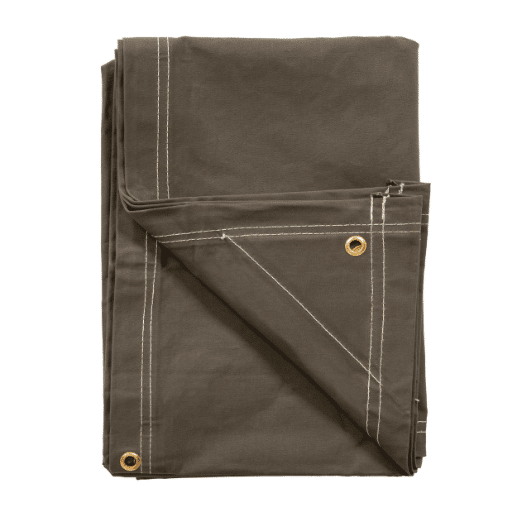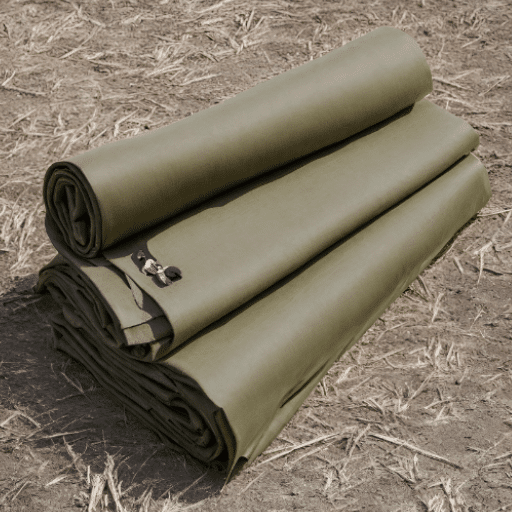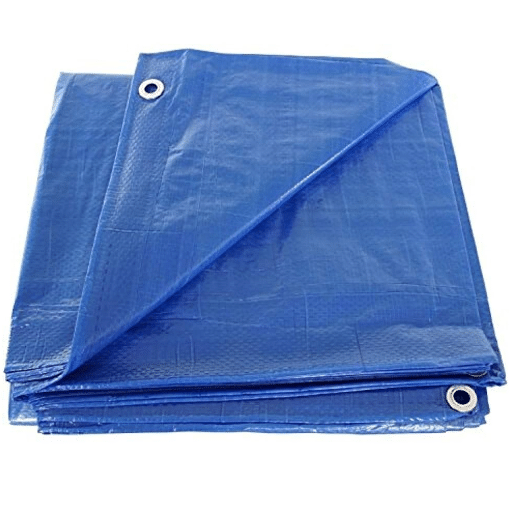For many, tarps seem to be the best option for protecting items from weather. However, not all tarps are alike, and one questions: Are all tarps truly waterproof? Knowing this difference between water-resistant and waterproof is paramount to ensure the tarps chosen are the appropriate kind for the job at hand. Going through with this article is a peek into the science behind a waterproof tarp, how they are made, and what makes them wear sooner or later. Whether it is outdoor equipment or vehicle covers being protected, or everything being laid out for an unpredictable forecast, this guide will allow you to make a wise choice.
Types of Tarps
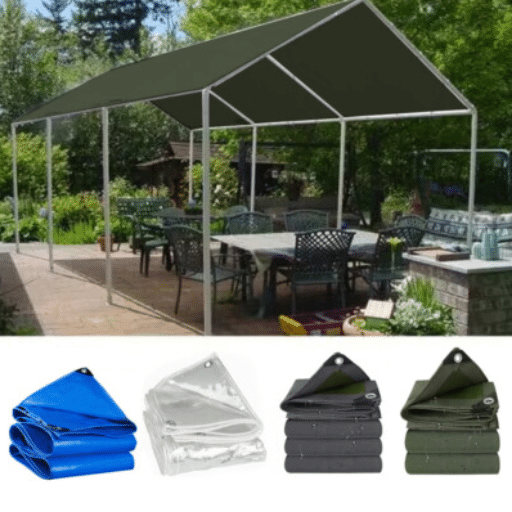
1
Canvas Tarps
They are very versatile canvas tarps, usually made of some heavy cotton or polyester material. Sometimes canvas tarps are treated with coatings such as wax or oil to increase their water resistance and durability.
Key Features:
- Breathable material prevents condensation buildup
- Best for machinery, wood, or agricultural products
- Eco-friendly and reusable option
- Popular in landscaping, construction, and recreation
2
Vinyl Tarps
Vinyl tarps are to medium-duty tarps what diamonds are to precious little stones, offering superior durability, water resistance, and tear resistance from their tarp brethren. They are capable of fielding strong environmental batterings from UV rays, chemicals, and temperature extremes.
Applications:
- Industrial and commercial usage
- Business and truck covers
- Containment systems for hazardous materials
- Cost-effective for long-term use
3
Heavy-Duty Tarps
These tarps are made heavy-duty to meet industrial and commercial demand. Their construction, which is very robust, usually using reinforced PVC or polyethylene materials, endows them with durability, water resistance, and protection against UV rays.
Professional Features:
- Sealed seams and corrosion-resistant grommets
- Superior strength under harsh climatic conditions
- Covering construction sites and weatherproofing
- Containment measures for hazardous materials
Waterproof vs. Water-Resistant Tarps
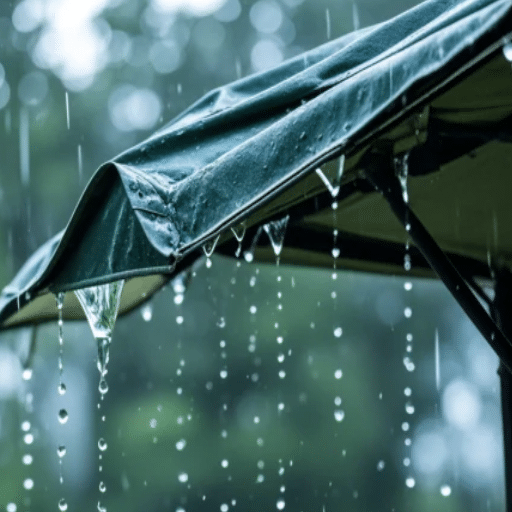
🛡️ Waterproof Tarps
Waterproof tarps are special cover materials that do not let water seep through them. They are made of strong materials like PVC (polyvinyl chloride), polyethylene, or vinyl, which are further treated or coated to impart impermeability to the tarp.
Key Characteristics:
- Totally impermeable to water
- Withstand hours of water exposure
- Suitable for heavy downpours
- UV-resistant and mildew-proof options
💧 Water-Resistant Tarps
Water-resistant tarps provide a barrier from moisture; that is, water is prevented from penetrating the material under the usual conditions. These tarps are made from polyethylene, vinyl, or canvas and possibly treated with some coatings for water repellency.
Key Characteristics:
- Great for shedding water
- Light to moderate exposure protection
- Cannot withstand prolonged soaking
- More breathable than waterproof options
🔍 Comparing Waterproof and Water-Resistant Properties
The scope of the exercise to determine what best suits the application becomes pertinent when combining the technical specification against user intent. Waterproof materials absolutely resist penetration of water, and most do so by way of impervious coatings such as polyurethane or polyvinyl chloride (PVC). These materials would be ideal when it comes to situations demanding extended exposure to heavy rain or being submerged in water.
Conversely, water-resistant materials are usually treated fabrics or tightly woven fibers that repel water only strenuously and are, thus, appropriate only for conditions of intermittent or light moisture. Consumers in quest of high-impact weather solutions opt more for waterproof tarps, whereas those who are more concerned about weight and portability lean toward the water-resistant options.
How Waterproofing is Achieved
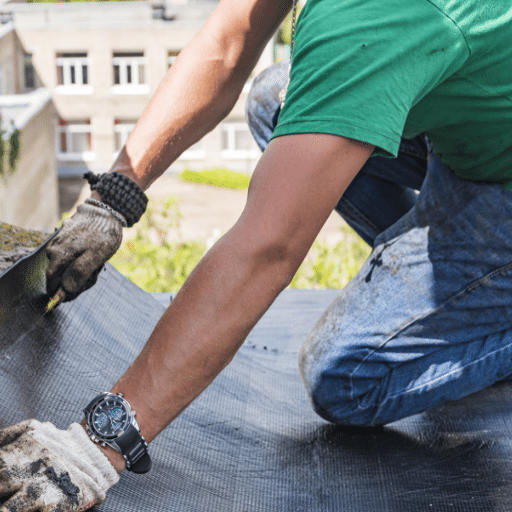
🧪 Material Composition
The composition of a waterproof product is essential to its functional realization. Generally, these materials may contain polymer membranes utilizing state-of-the-art technologies, such as polytetrafluoroethylene (PTFE) or polyurethane (PU), which prevent water from penetrating but still allow air to pass.
Advanced Technologies:
- Gore-Tex® microporous PTFE membrane
- Breathable waterproof jackets technology
- Lightweight waterproof gear innovations
- Nanotechnology coating applications
⚙️ Manufacturing Methods
Making advanced waterproof and lightweight materials is a melding of innovative techniques and consumer-oriented data insight. Manufacturers are tilting their popularity toward nanotechnology coating applications as well as advanced lamination processes.
Modern Techniques:
- Nanotechnology creates microscopic hydrophobic surfaces
- Precision lamination for seamless integration
- Multiple layer materials guarantee durability
- Thermal regulation maintenance
🔬 Testing for Waterproofing
Testing for waterproofing is assessed via exact methodologies to ensure all materials’ fulfillment of waterproofing standards. One common method employed in hydrostatic pressure testing subjects materials under required pressure of water to test their resistance to water.
Testing Methods:
- Hydrostatic pressure testing
- Spray simulation tests
- ISO 811 fabric waterproof testing
- ASTM D5385 hydrostatic resistance
Common Uses of Waterproof Tarps
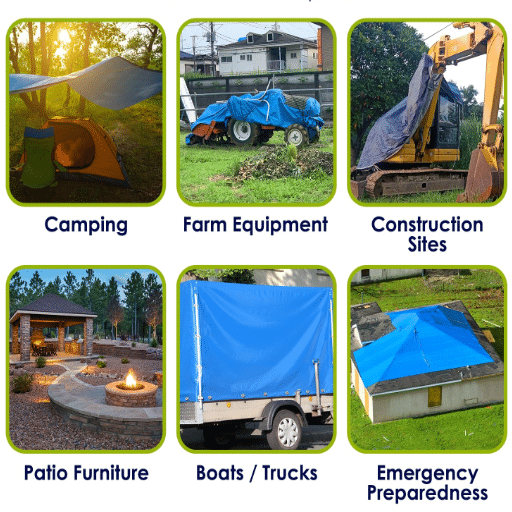
🏕️ Outdoor Activities
Waterproof tarps are most often sought by consumers in relation to camping, specifically for use as rainfly covers, tent footprints, and emergency shelters. Further probing suggests also their application in securing individual gear or equipment from moisture during hiking or kayaking.
Applications:
- Rainfly covers and tent footprints
- Emergency shelters
- Hiking and kayaking gear protection
- Lightweight, high-strength fabric needs
🏗️ Construction & Industrial
Waterproofing is invaluable to the construction and industrial sectors because structures and machineries face deterioration due to moisture. Innovation focuses on high-performance membranes, sealants, and coatings that are able to endure great stresses and long exposure to adverse environmental conditions.
Applications:
- Concrete structure protection
- Mechanical equipment covering
- High-performance membranes and sealants
- Abrasion and weathering resistance
🚨 Emergency Preparedness
Emergency and disaster preparedness is a critical system that allows individuals, communities, and organizations to react to crises so that risk may be diminished. Preparedness involves the development of an emergency plan peculiar to the identified risks.
Essential Steps:
- Risk assessment and threat evaluation
- Emergency plan development
- Emergency kit with essential supplies
- Regular drills and plan updates
Maintaining Your Waterproof Tarps
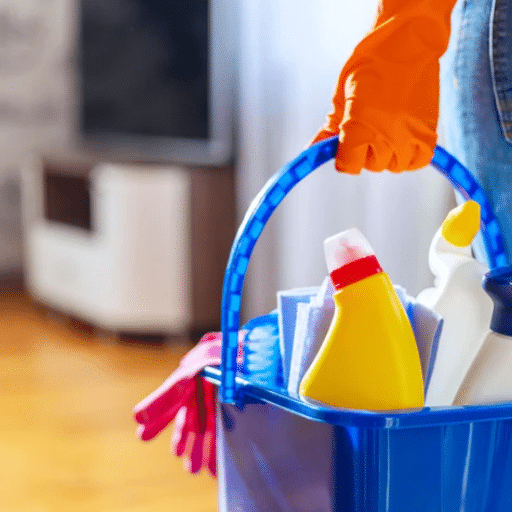
🧼 Cleaning and Care Instructions
For the life and performance of waterproof tarps, proper cleaning and care are paramount. Latest data and expert recommendations state that the first step is to clean off loose dirt and debris with a soft brush or compressed air.
Cleaning Steps:
- Remove loose dirt with soft brush
- Use mild soap with warm water
- Scrub gently with non-abrasive sponge
- Rinse thoroughly with clean water
- Allow complete drying before storage
⚠️ Important Notes:
- Avoid harsh chemicals or abrasive cleaners
- Never fold and store while moist
- Prevent mold or mildew growth
- Regular inspections for wear and tear
📦 Storage Recommendations
When storing tarps, it is best to fold the tarps neatly along their seams as much as possible so that creasing and undue stress are not placed on any one section.
Best Practices:
- Airtight storage containers
- Temperature-controlled environment
- Keep tarps off the floor
- Away from pests and damage
🔧 Damage Repairs
After a tarp gets damaged, it’s vital that it be repaired properly to extend the life of the tarp and to maintain it in working order. Start by inspecting the damaged area to assess the extent of the problem.
Repair Solutions:
- Vinyl or polyethylene repair tape
- Patching kits for serious damage
- UV-resistant waterproof glues
- Clean and dry surface preparation
Frequently Asked Questions (FAQs)
❓ Are All Tarps Waterproof?
Not all tarps are waterproof, with some serving the purpose of being water-resistant. A waterproof tarp is something that is treated or constructed with materials that prevent water penetration. A water-resistant tarp, on the other hand, can allow some moisture to seep through in certain unfavorable weather conditions.
🏗️ What Are Heavy Duty Waterproof Tarps Made Of?
Heavy duty waterproof tarps are made from quality materials such as polyethylene or vinyl, which provide the best durability and resistance to environmental factors. They come in a variety of thicknesses, and for example, 20 mil heavy duty tarps carry the substantial weight of protection for rough uses.
🎨 Can Canvas Tarps Be Waterproof?
Canvas tarps could be waterproof, depending on the treatment given to the fabric. Canvas, as well as being water-resistant, is also converted into many waterproof canvas tarps that are treated with coatings that prevent water from penetrating through.
💪 What is the Durability of Waterproof Vinyl Tarps?
Waterproof vinyl tarps are known for their durability and are therefore a common choice for heavy-duty purposes. Made from good quality vinyl materials, these tarps resist tear, corrosion, and UV rays withstanding harsh weather conditions.
🛡️ How Do Heavy Duty Tarps Keep Water Out?
Heavy duty tarps are made from some special materials and constitute some particular construction processes that make them very good at keeping water out. In most cases, multilayers are involved, and seams are reinforced, preventing moisture from getting through.
🔹 Are Poly Tarps Waterproof?
Poly tarps, or polyethylene tarps, are claimed to be waterproof; it is just a matter of buying the right type. Many poly tarps are designed with waterproof characteristics to cover the things and shield against moisture.
📚 Reference Sources
Boston University Blog
Versatility of Striped Tarpaulins – Discusses waterproof properties of tarpaulins made from durable polyethylene plastic, highlighting strength and flexibility.
UC Agriculture & Natural Resources
Tarping for Weed Control – Explains the use of tarps for agricultural purposes, emphasizing waterproof and UV-resistant properties.
Butler University Blog
Best Truck Tarpaulin Options – Highlights waterproof and durable nature of PVC tarpaulins, resistant to abrasion and chemicals.

